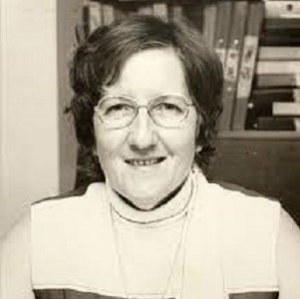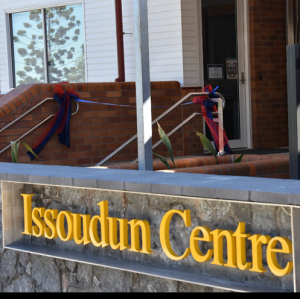Peter MALONE
Asterix & Obelix: The Middle Kingdom

ASTERIX & OBELIX: IN THE MIDDLE KINGDOM
France, 2023, 112 minutes, Colour.
Guillaume Canet, Gilles Lellouche, Vincent Cassel, Jonathan Cohen, Marion Cotillard, Julie Chen, José Garcia, Audrey Lamy.
Directed by Guillaume Canet.
This further adventure in the story of Asterix and Obelix and the Gauls in 50 BC is dedicated to the memory of the originators of the comics, strips and books.
|
This time there is a new cast, led by its director, Guillaume Canet, who is working with actor friends with whom he had appeared in films like Little White Lies. These include his partner, Marion Cotillard who appears here is a somewhat hysterical Cleopatra. Canet himself plays Asterix, rather diffident, a bit wimpish, not as smart as he might hope to be. But, the surprise is the absence of Gerard Depardieu but his role as Obelix being more than filled by Gilles Lellouche. He is an actor who appears in very serious films, criminal, police, investigator… But, he enters into the spirit of thing with great zest, obviously enjoying himself in the role of the large Obelix. Vincent Cassell also appears as Julius Caesar. The humour of the film is, to say the least, very broad. Subtlety is not its hallmark. And a number of fans have dismissed it because of this broad, for them too broad, humour. However, audiences entering into the spirit of the previous stories, the previous films, both animated and live-action, will get some chuckles and laughs. One of the best sources of humour is in the names of the characters, especially the English versions, words ending in IC becoming words ending inIX. And a whole lot of puns like Biopix, Vitalstatistix. While the whole thing is farcical, uprisings in the kingdoms of China, a princess escaping to Gaul accompanied by her bodyguard (who is called Ka Ra Te), her mother imprisoned with a business wheeler dealer from the West. They arrive in Gaul, seek the help of the Gauls and Asterix and Obelix volunteer, Asterix is enamoured of the Princess, Obelix infatuated with the bodyguard (and she with him). Accompanying them is a two-timing coward character who is also infatuated with the Princess. And so a track by land and sea to China, dastardly enemies, imprisonment of the Empress, battles and confrontations. Meantime in Rome, there is Caesar, some rather idiotic characters and behaviour at the court, Caesar being persuaded to march East in the steps of Alexander the Great to deal with the problems of China. And domestic problems with Cleopatra and her falling in love with a bodybuilder. With Chinese background and the bodyguard, there is quite a lot of martial arts action throughout the film – some of it humorously absurd when Asterix takes his potion and has superpowers, with Obelix and his ordinary strength, hurtling enemies up into the stratosphere and having to wait a long time for them to return! There is also a romance, a mysterious Prince in China, leading to disappointment with the princess’s suitors, but a happy wedding back in Gaul. There is a great deal of music in the score, and some humorous uses of popular songs, Caesar and the legions with a chant from Bohemian Rhapsody, the romantic tones of Lionel Richie and Say You, Say Me, and a funny parody of The Time of Your Life from Dirty Dancing and a parody of the famous leaping scene. Some of the other films, both animation and live-action have been cleverer, more enjoyable, but, in the meantime, this will have to do. |
... |
Ema
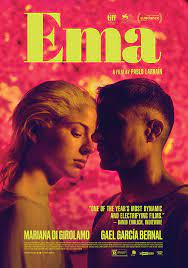
EMA
Chile, 2019, 104 minutes, Colour.
Mariana Di Girolamo, Gael Garcia Bernal, Santiago Cabrera, Paola Giannini, Cristian Suarez.
Directed by Pablo Larrain.
Emma is an intense character, fiery Latin American, from Chile, the city of Valparaiso, with one critic referring to her as wanting to dance to our own choreography.
Ema has been written by celebrated Chilean director, Pablo Larrain, who made impressive films in his home country, Tony Manero, No, as well as international films, the portrait of Jacqueline Kennedy, Jackie, and the portrait of Diana, Princess of Wales, Spencer. Mariana di Girolamo in an intensely fiery performance as Ema, as a dancer, as a woman seeking love, experimenting in relationships, attempting to be a mother, attempting to be a wife. Gael Garcia banal has collaborated with Pablo Larrain in Neruda and No.
The film is memorable in some of its striking dance routines, theatrical, through the streets of the city, rehearsals, teaching children in schools – and in the theatre, a large ensemble, costumes, choreography, an extraordinary backdrops with cosmic overtones.
The human drama is complex, a married couple and their trials, the sterility of the husband, suggestions about his sexual orientation, an attempt at adoption, the child creating a fire and the giving him back to the adoption agency, the contact with his next adoptive parents, difficulties in relationships, promiscuity…
Universal themes but presented with an intense and fiery Latin American perspective.
- A Chilean story, Chilean characters and dilemmas, universal?
- The city of Valparaiso, Chile and atmosphere, homes, streets, dance theatre, schools and classrooms, the countryside? The musical score?
- The theatrical atmosphere, the music, songs, performance? The large ensemble, the dance movements, style, atmospheric backdrops, theatre performance around the city, in the classrooms? The dance routines around the city, the flamethrower?
- The portrait of Ema herself, her background, intensity, fire (and the symbol of fire throughout, the opening with the traffic lights on fire)? Her dancing? Her family background? Domestic sequences? Her marriage to Gaston, his stability, issues of sexual orientation? The adoption of Polo, the hopes for a family, his age, inexperience, the fire incident, giving him back to the adoption agency, the effect on each of them? His later reappearance, at the school, Ema and her wanting to start again with him?
- Ema, a person in torment, passion, the breakup of her marriage to Gaston, the consequences, her relationship with the women in the dancing group, their personalities, attitudes, sexuality, the liaison is? The effect?
- Anibal, his character, his work, the link with the troop, the attraction to Ema, his wife and family, the tensions, the affair and the consequences, Gaston and reaction, and the irony of the relationship of the wife with Ema?
- Gaston, with the dance troupe, the putting of performances, rehearsals, the dancing, the evocative symbolism? Gaston, with the group, somewhat lost, the flashbacks to the past with Ema, the attempted some kind of reconciliation? Her wanting to be liberated?
- A portrait of two people, in relationship, love, out of love, clashes, crises?
Limbo/ 2023

LIMBO
Australia, 2023, 108 minutes, Black-and-white..
Simon Baker, Rob Collins, Natasha Wanganeen, Nicholas Hope, Mark Coe, Alexis Lennon, Joshua Gloria.
Directed by Ivan Sen.
Limbo has a religious meaning, not quite heaven, exclusion from heaven – or, as some commentary in this film notes, on the edge of eternity, the edge of hell.
So, the fictional town here is Limbo, on the edge of nowhere, out in the desert, remote. In fact, the filming was done in South Australia, in Coober Pedy, noted for its moon-surface-like landscapes, desert, hills, caves, for mining, and its distinctive motels and underground accommodation, and its underground church. It is quite striking, filmed in black and white, and opening with an aboriginal painting, symbolic stones, and the switch to this landscape of stones and hope for opals.
The director is Ivan Sen who, for 20 years, has focused on indigenous themes, and focusing on indigenous children, Beneath Clouds and Toomelah, and here there is sympathetic focus on young aboriginal children. But Sen has also been interested in detectives and police investigations, especially with his significant character, Jay Swan, a black detective in Mystery Road, Goldstone (and with Sen producing television sequels and an Origin story).
He continues his interest in police investigations but this time the detective is an outsider, white, Travis Hurley, with a thoughtful and intense performance from Simon Baker. He drives through the harsh landscapes, listening to religious programs on his car radio, finding the room in the underground accommodation at the Limbo Motel, then taking a drug fix.
Life is not rushed in Coober Pedy nor is it in this limbo. Travis slows down to the pace, first trying to contact Charlie Hayes, Rob Collins, brother of a girl who was abducted and presumably murdered, no trace of her grave. The case is 20 years old but is being reopened. So, most of the quiet action, often slow action, is Travis beginning to bond with Charlie Hayes, contact with his sister Emma (Natasha Wanganeen) working in a cafe, fostering some children. And he has a lead to a white opal miner, Leon, discovering he is dead but talking with his brother, Joseph, Nicholas Hope.
Gradually, sometimes very gradually, some more leads are forthcoming, from indigenous men who were young at the time, careful in giving information but providing enough for Travis to work on.
Travis has a back story, drugs squad, taking drugs, wife leaving him, taking their son whom he has not seen. This has repercussions for Zac, a young boy fostered by Emma, Travis enabling him to make contact with his father, motivated by his own loss of his son.
In a way, the mystery is solved, or, at least, suggestions of the solution and how it affects Travis emotionally as officials close the case and he is ordered back to the city, some homicide investigations.
This portrait of life in Limbo is a reminder of life in in towns, like Alice Springs, where black and white live together but there is inherent racism, violence, and a growing lawlessness amongst the youngsters and difficulties for control and for law and order.
Limbo is an interesting watch, and timely.
- The Australian story, the outback, indigenous people, white settlers, tensions?
- The South Australian settings, Coober Pedy and its landscapes, underground accommodation, the church? The hills in the desert, the peaks, the caves, mining, opals? Homes, trailers, the wrecked cars, the supermarket? The musical score?
- The work and interests of the director, Ivan Sen, indigenous themes, his film career, writing, directing, composing scores, editing?
- Simon Baker as Travis Hurley, detective, his back story, separation from his wife, her taking his son, his regrets, not seeing him, dreaming about his son? Drug squad, killing a man, taking drugs and continuing, the religious broadcasts on his radio? His coming to the town, the 20-year-old case, his investigation?
- Limbo, the town and the motel, theological meaning of limbo, edge of eternity?
- The drive through the desert, the visuals of the desert, overhead shots, the vastness, dry, moonscape land? The motel? The underground room, the corridor? Settling in, drugs, exhaustion?
- Charlie Hayes, Travis going to his trailer, reticence? Not accepting his card, Travis putting it on his truck? The contacts, talking, memories of his sister, regrets at her death, disappearance, 20 years, talk in the town? Charlie being accused, Oscar and his friend denouncing him, police harassment? Take him to see Oscar, taking him to see Stan, Stan and the indirect communication, gradually building up something of a picture?
- The car, the kids, law in the town, the kids running wild? Stealing from his car, renting the car while in town?
- Looking for Leon, going to his home, finding Joseph, brother, story of Leon’s death? Joseph, his age? Living alone, out in the cave? The dog? Travis seeing him in the church, going to confession? Stories about Leon, liking aboriginal girls? The parties, Charlie and Emma going to the parties, Emma talking about the consequences? The visits to Joseph, the final visit, in bed, dying, a realisation of his guilt, Leon’s grave, the possible grave for Charlotte? Travis holding the gun to his head, not shooting?
- Emma, love for Charlotte, the past, going to the parties at Leon’s, her working at the cafe, the girls, her boyfriends, concern about Zac and his wildness, contacting Travis, giving some information, out on the hill, the girls and their playing, curiosity, asking him questions? The invitation to the meal, his uncertainty, taking the drug shot, going, the meal, the girls and their continued questions, their backgrounds? Very direct? Emma and her drinking, provocation, Travis leaving, her apology the next day?
- Life in the town, Emma and the girls going to the supermarket, the cool of the air-conditioning, modern? Cars, parking? The church, underground, the record playing with the descriptions of the art work, the priest coming out, hearing Joseph’s confession, the tourist bus arriving in his welcoming them?
- The indigenous presence in the town, jobs, no jobs, the groups, the traditions, talk of Walkabout, dancing, Charlie and his drinking, painting his face? The silence, the stories, hidden?
- Travis finding Zac, with the group, in the car, talking about his father, arranging for him to go out to Charlie’s trailer, their talking together? Travis taking him home to Emma? The effect on his life? Travis’s motivation, his own son and distance?
- Getting his car back, the visit to Joseph’s cave, the closing of the case, explaining this to Emma, the phone calls, further homicide cases, his leaving?
John Farnham: Finding the Voice
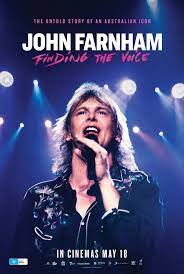
JOHN FARNHAM: FINDING THE VOICE
Australia, 2023, 95 minutes, Colour.
Directed by Poppy Stockell.
Here is a very Australian documentary, an opportunity for an older demographic, those who remember well the late 1960s, as well as for the demographic born in those years and who remember well the late 1980s. This the story of John Farnham’s career.
In many ways, it is a very straightforward presentation: the outlines of his biography, his initial singing successes, the experience of a slump, experiences with the Little River Band, the revival of his career, beyond expectations, with his album, Whispering Jack, and the key song, The Voice, released September 1986.
The Farnham family migrated from England in 1949. With the possibility of a plumbing apprenticeship, he was encouraged by his family to follow offers to sing in commercials. And, then, at the age of 18, the song that was to characterise his early life, lead as well to a great deal of rejection, Sadie, the Cleaning Lady, which audiences enjoyed at the time, making him from the age of 20, the celebrated King of Pop (even crowned, as we see, by no less than Liberace). Johnny Farnham was popular, swooned over, eager to entertain the crowds.
This documentary has a great number of interviews, as well is footage from celebrities from the past, especially Olivia Newton John, Jimmy Barnes, and later Celine Dion and other singers. The anchor of the documentary is Gaynor Wheatley, wife of Little River Band organiser, Glenn Wheatley, becoming John Farnham’s manager, personal friend, loyal promoter for his success over many years. The interviews with Gaynor Wheatley add a personal dimension to the story – and there are comments from John Farnham’s wife, Jilly, and appearances by his sons, Robert and James.
As regards Farnham’s career, there are plenty of songs, performances, reaching out to audiences, with popular hits like Raindrops Keep Falling on my Head. But, Sadie was to haunt John Farnham, especially when he made more recordings and broadcasters and producers relegated him to the past, just a pop idol.
The audience shares the uncertainties of the 1970s into the 1980s, some good times with the Little River Band, replacing its main singer and composer, Glenn Sharrock, but then disputes within the band, many feeling that they were just a backing for a solo star. And some very uneven times singing with a less than talented band. And, then, the rescue by Glenn Wheatley.
And, all the time, comments and support from the interviewees.
Which means that while the 1970s into the 1980s offer some drama, the atmosphere is rather sad, Farnham even experiencing some depression.
Of course, this documentary comes to energetic life in portraying the search for a song to complete a new album, Whispering Jack, Farnham listening to many tapes, and the final choice of The Voice, the British writer saying no to Farnham singing it, the group going ahead, finding a group of young musicians including composer, David Hirschfelder, who arranged the song, introduced bagpipes, changed the key – and the risk and uncertainty of promoting the song.
And the rest, as they always say, is history. An extraordinary revival of career, topping the charts in Australia (still a record), overseas, tours around the world, enthusiastic footage of a concert in Germany.
The narrative includes Glenn Wheatley’s involvement in tax fraud and prison sentence, John Farnham always loyal, then it takes us up to the pandemic, the sad news of Glenn Wheatley’s death with complications from covid, information about Farnham himself going to hospital for throat surgery and cancer.
With his clear voice, his enthusiastic communication, and, it would seem, being a very decent bloke, John Farnham has a significant role in Australia’s cultural and musical history.
Fast X

FAST X
US, 2023, 140 minutes, Colour.
Vin Diesel, Michelle Rodriguez, Jason Momoa, Jason Statham, Jordana Brewster, Tyese Gibson, Chris Ludicris Bridges, Nathalie Emanuel, Charlize Theron, John Cena, Sung Kang, Helen Mirren, Brie Larson, Scott Eastwood, Alan Ritchson, Daniela Melchior, Leo Abelo Perry, Joaquim de Almeida, Rita Moreno.
Directed by Louis Leterrier.
What can anyone say! The tenth movie in a franchise that has been popular for 22 years, a surprising hit in 2001, The Fast and the Furious. The original had its origins in street racing in American cities, adding police themes, undercover agents, street criminals who in subsequent films not only made good but became saviour-figures. And the importance of family, the family unit, especially Dom’s young son, in on the action, but also the family of friends and colleagues. And that has been repeated for the 20 years.
A popular television series, released, perhaps, to coincide with the release of Fast X, Icons Unearthed, features the writers, the producers, the way that the first film developed and segued into the others. But, what is emphasised is the nature of American fascination with fast cars, driving, competitiveness, and the assumption that this is popular worldwide. (Box office indicates that the assumption was correct!) There are many interviews with the writers showing how they could come up with more and more spectacular ideas for car stunts, crashes, cars in the air, landing on boats… And interviews with the stunt persons who actually did the spectacular driving.
As the series went on, the stunts became more and more far-fetched – and, in this tenth episode, they are even much more further-fetched. And, one might add, Dominic Toretto and his colleagues, now in their 40s, might have lost some of their touch in being exploited by movie villains, but are still driving-fit.
Which means then that it would probably would suffice for a review in using such words as: smash, crash, bash, crunch… And there is plenty of that in a film which goes for two hours 20 minutes, lots of stunts, and lots of fistfights.
Actually, the word that comes to mind while we are actually watching these events, the crashing and smashing, is “preposterous”. How could someone come up with the idea of an enormous bomb loaded on a plane to be dropped on Rome and to go careering through the narrow city streets, down the Spanish Steps, over Tiber bridges, veering towards the Vatican? And how could someone imagine Vin Diesel careering at speed through these Roman streets (for those who know Rome most is not the real thing, but artificial sets which are not all that realistic), car manoeuvre to smash the bomb into the Tiber where it blows up.
In fact, the film has a prologue, a story invention ten years earlier in Brazil, involving the late Paul Walker using past footage of him, the thwarting of a mega-rich Brazilian crook and the stealing of his large safe, dragging it through the streets of Rio. But this is the occasion to introduce the son of the crook, Dante, who has waited ten years to wreak his revenge on Dom. He is played by Jason Momao, rather different from his Aquaman, this time a combination of brutality, and an effeminate maniacal personality. Certainly a different kind of villain.
And the stunts, cars landing in planes, cars attached to two helicopters over a Brazilian freeway… What will they think up next – and they will!
And for those who enjoy scenery, sequences in Brazil, principally, but also in London, and, of course, Italy.
In looking at the cast list, we see that so many of the old favourites in the extended family are back again, including a villainous Charlize Theron who has moments of repentance, helping Dom’s wife, Letty, Michelle Rodriguez (and a preposterous-plus rescue at the end from the submarine from past films), and Helen Mirren with her bloomin’ East London accent, and a scene with Jason Statham. But, this time, two more Oscar winners besides Theron and Mirren, Brie Larson as an agent, and Rita Moreno, at 91, the family matriarch.
Which means that this review of the film – which has gained $370 million worldwide in its first days of release-is superfluous. Smash, crash, bash and, especially, preposterous, might have sufficed.
Bangla
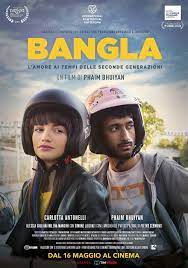
BANGLA
Italy, 2019, 84 minutes, Colour.
Phaim Bhuiyan, Carlotta Antonelli.
Directed by Phaim Bhuiyan.
The story of refugees from Bangladesh settling in Italy, living in Rome, setting up business there, their children being born there and growing up Bangla-Italians. In fact, this is the kind of story that is more familiar to English-speaking audiences because they are set in London (more stories from Pakistan than Bangladesh).
The star of the show is the writer-director, Phaim Bhiuyan, playing a Bangla character, born in Italy, aged 22, working as a guard in an art gallery (with some amusing scenes of him standing guard, silently, warning people against touching, a signal that sounding when somebody transgresses!). He also plays in a band, has some friends who give him advice, especially one contemplative type from whom he bounces ideas. He has a younger sister who is about to be married, clashes with her brother, questions the wisdom of the marriage, indulges in the preparations with her very busy mother, the father at home, dispensing wisdom and memories. And the wedding itself.
Phaim is awkward in so many of his dealings, especially with women, but encounters a rather forthright Italian woman who is attracted to him, and he, at first tentatively, to her. This involves a visit to her family home, a very brisk Italian family home. But Phaim is uncertain, seeks advice, goes out, is awkward, the Italian girl asking him embarrassing questions about sexuality, his gawking in responding.
With advice, he makes a decision not to see the girl again but she appears, the friendship starts again – and, with hopes that it will lead to a happy future.
Torn Hearts
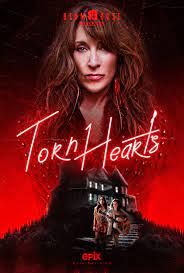
TORN HEARTS
US, 2022, 97 minutes, Colour.
Katie Sagal Abby Quinn, Alexxis Lemire, Joshua Leonard, Shiloh Fernandez.
Directed by Brea Grant.
This is very much a women’s project, writer, director, central characters, two men in supporting roles.
The film has a prologue set in the 1990s, a television interview with two singers, sisters, hugely successful.
Then the film opens in the present like a country music film, two young women, the group called Torn Hearts, singing, acclaim from the audience, full of hopes for their future. One is played by Abby Quinn, the more outgoing, pert, cheeky singer with Alexxis Lemire as the more straightforward, attractive singer. As the film progresses, we see something of a role reversal with them, friendship, challenges to friendship, egged on to hostility.
Their agent introduces them to a young singer and they hope to have a supporting role with his group. One girl spends the night with him but is disillusioned when the plan is for an all-male supporting group. However, she gets information about a retired singer, Harper Dutch, and where she lives. The two girls then go to the house, with a gift of cheesecake, allegedly the singer’s favourite, make a pitch to come in to ask her advice and, after hesitation, she lets them in. Fatal mistake!
Harper Dutch is living alone, after the death of her sister, with a great deal of memorabilia of the sister around the house, and a room which is equivalent of her shrine. Sinister implications, sinister explanation later.
Harper Dutch is played by veteran Katie Sagal, who in her early career, played in bands, supported Gene Simmons and Kiss, was supporting singer to a number of stars, including Bette Midler. On television she played in 260 episodes of Married With Children. This brought her quite a worldwide following.
Here, she is obviously enjoying her role, the famous star in retirement, wealthy, a mansion, able to welcome visitors or reject them. The main drama is with the two girls, infatuated, wanting to do a demonstration, asking the star’s advice, performing for her.
But, the country music aspect is way to horror tropes. This is a Blumhouse production, noted for its very successful range of horror films over the years, and information given that this film was made in producer Jason Blum’s own house.
What follows is growing menace, the singer persuasive to her young visitors, drinks, drugs, waking up, memory loss, the singer becoming more commanding, demanding they make breakfast and then rejecting it, spurning them, ridiculing them, contradictory whims yet being seductive in suggesting that they sing with her and make a recording.
Then there is a change of character in each of the girls, the pert girl banished to a basement where she discovers the truth about the dead sister, murdered by her jealous rival sister. The other girl plays up to Harper Dutch. Harper Dutch taunts and tantalise is, getting the girls to physically attack each other fight, express their inner feelings towards each other.
Then the agent arrives, has known Harper Dutch in the past, plays her games in terms of promotion – and then she kills him.
So, more of a horror film, the threats to the girls, fights, knives, wounds and blood, and a final bloody confrontation which does not lead to a happy ending or a happy future.
It would be interesting to do a survey of male audiences to see whether they liked the film, identified with it or not – probably not. As said earlier, this is a women’s film project.
Merle Salazar fdnsc, new companion of the Laity of the Chevalier Family
Merle Salazar fdnsc, new companion of the Laity of the Chevalier Family

The Trigeneralate and the International Council of the Laity of the Chevalier Family are delighted to announce that Sr Merle Salazar fdnsc has accepted the invitation to become the new companion of the laity. Sr Merle will work together with Fr Hans until the Assembly in Cebu, where she will be welcomed and commissioned.

Sr Merle, a Filipino born in Tarlac in 1968, is a member of the Congregation of the Daughters of Our Lady of the Sacred Heart, an international missionary congregation founded in France in 1874. Prior to joining religious life in 1995, she was a Certified Public Accountant and worked as a manager for Budget and Financial Planning. She made her first profession in 1998.

As a religious, she served her Congregation in the areas of formation and administration. In addition to her training as formator, she also pursued graduate studies and earned a Masters in Religious Studies major in Scripture from the Institute of Formation and Religious Studies writing a thesis on Mary, the Mother of Jesus. She promotes knowing Our Lady of the Sacred Heart as Mother-Disciple of Jesus.
In 2011, she was elected to her Congregation’s General Council. While at the General Council, she was in charge of formation and the accompaniment of their lay members. She was in this role until September 2022.

In her almost 11 years in their General Council, Sr Merle saw the beauty and the necessity of the partnership in mission between the religious and the lay members of the Chevalier Family. She sees this partnership and collaboration as essential, not only for the future, but in the present; not only in countries where the number of religious has diminished or is diminishing but also in places where there are still many young religious. We have been gifted with the beautiful mission of making the love of God experienced wherever we may find ourselves. What better way to fulfill this mission than TOGETHER, lay, religious and priests, journeying together, one in the Heart of Christ.
RIP, Doctor Ellen Mary Stack (1929-2023)
RIP, Doctor Ellen Mary Stack (1929-2023)
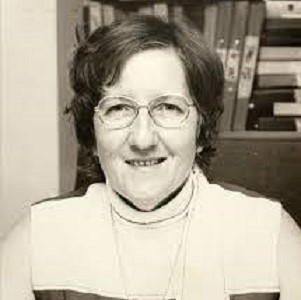
From Malcolm Fyfe MSC, Vicar General, Darwin. “I write to tell you that another iconic Northern Territorian and outstanding Catholic has passed from this world to the next. DOCTOR ELLEN MARY STACK died yesterday at the age of 94.
The photo above is how I remember her from my earlier stint in the diocese (1978 to 1983 incl.)
(Doctor) Ella Stack – as we all referred to her in those days, was the go-to person for just about anything. All members of the clergy and religious knew that they would get an attentive hearing and reliable solutions to their concerns, whether of a medical, religious or political nature. Ella must rank as one of the Territory’s truly “Greats” and one of the Darwin Diocese’s outstanding Catholics. She was ahead of most others in just about every field – her spirit of faith, compassion, medical experience and availability, women’s rights, First Nations’ culture and their needs.
I can add that Ella had an especially warm relationship with Bishop John Patrick O’Loughlin, with the Daughters of Our Lady of the Sacred Heart and with the Missionaries of the Sacred Heart (40 or so of us at the time). During my time up here (‘78 to ’83) I experienced countless instances of support in a variety of circumstances: nothing ever seemed to be too much trouble for Ella…
Long term Catholic residents of the NT will be interested to read more about her life. I attach the following (from Wikipedia)
Ellen Mary Stack CBE (born 4 May 1929) was an Australian medical doctor and the first female Lord Mayor of an Australian capital city. She was the mayor of the City of Darwin, Northern Territory from 1975 to 1979, and Lord Mayor from 1979 to 1980. She is best known for her work following the destruction of Darwin due to Cyclone Tracy.
Early life: Doctor Stack was born in Sydney in 1929, the daughter of William and Elizabeth Stack. She attended Brigidine Convent in Randwick and went on to study piano at the Conservatorium of Music in Sydney. Ellen Mary Stack (Ella) married Thomas (Tom) Lawler, an agricultural scientist, in 1957. They had three sons.

Photo: University of Sydney
Medical Career: Ella Stack graduated in 1956 with a Bachelor of Medicine, Bachelor of Surgery from the University of Sydney where she was a resident at Sancta Sophia College. She then became a Fellow of the Royal Australian College of General Practitioners and worked in obstetrics and gynaecology. She worked in Wee Waa and Narrabri in the Namoi Valley before moving to Darwin in 1961. Working at a clinic in Parap, she was one of only two private practitioners in Darwin at the time. After her time as Lord Mayor of Darwin, she completed a Masters of Public Health from the University of Sydney. She then returned to Darwin, becoming the first Assistant Secretary of the Division of Aboriginal Health at the Department of Health of the Northern Territory. She became the Chief Medical Officer of the Northern Territory in 1987. Doctor Stack was instrumental in the establishment of Menzies School of Health in 1985. She wrote about and commented publicly on public health and community issues, such as abortion and women rights.
Cyclone Tracy and life in Darwin: After moving to Darwin in 1961, Doctor Stack became increasingly interested in politics. She was elected to the Darwin City Council in 1969 and became Deputy Mayor in 1974. She and her family survived Cyclone Tracy, despite the destruction of their house. Doctor Stack decided not to evacuate Darwin, instead running an emergency clinic at Darwin High School, which became the main shelter and evacuation centre after the cyclone. She was responsible for the health care of 11,000 people who passed through the centre. "Not only did I look after the people that came in, but also people came and lived here," she said. "They brought their sodden old mattresses with them... I used to do a ward round every day and call them the sodden mattress lot." Doctor Stack was pivotal in establishing the Darwin Disaster Welfare Council, that would later become the Northern Territory Women's Advisory Council. Stack became involved in reconstruction efforts. She was elected mayor of the City of Darwin in May 1975 and automatically became a member of the Darwin Reconstruction Commission. Stack was re-elected Mayor of Darwin on 30 April 1978. Stack became the first Lord Mayor of Darwin in 1979 when it became a capital city. She was the first female Lord Mayor of an Australian capital city. Stack was made Commander of the Order of the British Empire in 1979 for services rendered to the people of Darwin following the cyclone. Stack resigned as Lord Mayor in May 1980 to run for the Country Liberal Party as candidate in the seat of Fannie Bay in the June election. She lost to the incumbent, Pam O'Neil. In 1985, Stack served as the Northern Territory representative on the first National Australia Day Council.
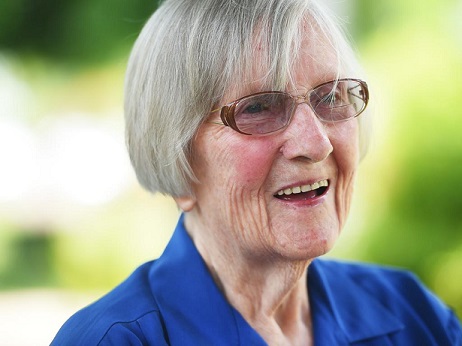
A recenet photo:NT Mews
Ella Stack on Cyclone Tracy: “In 1974 I was elected Deputy Mayor. The arrival of Cyclone Tracey in the early hours of Christmas Day 1974 changed everything, 66 people were killed and the city was all but completely destroyed. My surgery was blown away and all my patient records were lost. There were very few buildings left standing in the city, fresh water was not available and there were no electrical power or sewerage services. Foodstuffs were practically non existent. Because the cyclone had destroyed the city’s infrastructure, the stage was set for the onset of many communicable diseases. It was decided to evacuate the city by air to the southern capitals as quickly as possible.
As a temporary measure, the largely undamaged Darwin High School was used as a shelter for the homeless until they could be evacuated. I opened an emergency clinic within the Darwin High School, where I administered medical attention to the injured and immunised both adults and children against typhoid and tetanus. Of the pre-Tracey Darwin population of 45,000, 30,000 were evacuated by air in 11 days, and of these evacuees, many of whom needed medical attention as well immunisation, 11,000 passed through the Darwin High School.

Photo: National Museum of Australia
I stayed on in Darwin after the cyclone and I became very involved in the reconstruction of the city. As I was elected Mayor of the City in May 1975, I automatically became a Member of the Darwin Reconstruction Commission. This was a very interesting time in the development of the new Darwin. A new building code was enacted to prevent similar devastation in the future. I became the first Lord Mayor of Darwin in 1979 when Queen Elizabeth II created the Lord Mayoralty of the city. (The University of Sydney School of Medicine, Online Museum )
Blessing of the new Issoudun Centre, Downlands College
Blessing of the new Issoudun Centre, Downlands College

The Opening and Blessing of the Issoudun Centre, the new Prep to Year 4 precinct.

Downlands is now a P-12 School.

Bishop McGuckin blessed and opened the buildings.

Basketball court

L to R: Anne McAtomney (Chevalier Institute Director), Ian Mendes (former Business Manager, now Business Manager of St Joseph’s College Sydney), Stephen Koch (Principal), Rebecca Brownhall (Head of Junior School), Vince Carroll MSC (Chaplain).

Bishop McGuckin and Vince Carroll


